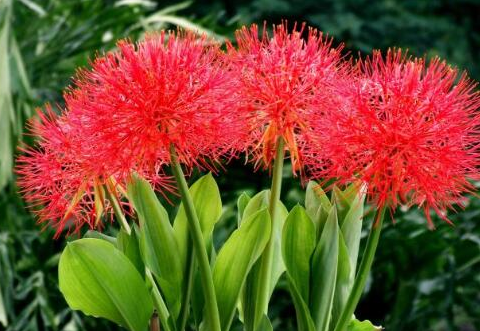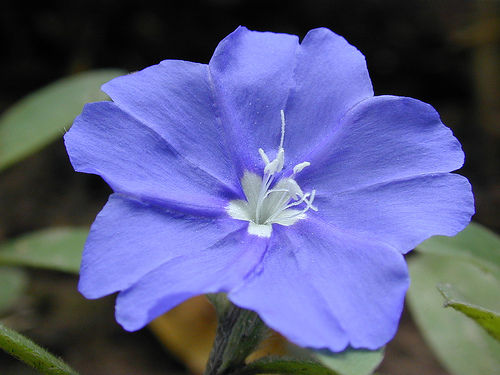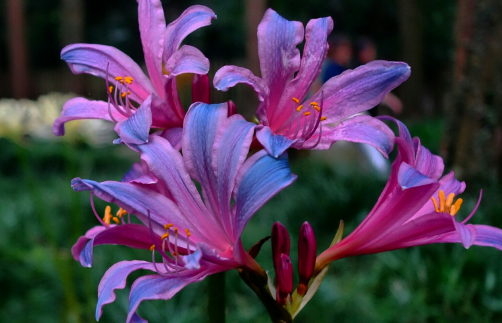Propagation method of tennis flower
Bulblet reproduction
Tennis flowers are generally propagated in spring, take out the plants, shake off the soil, gently break off the new balls around the mother ball, and plant them respectively. Usually tennis flowers need to be propagated once every two or three years, and the bulbs can not be buried too deep, and a small amount of water can be watered after germination.

Sowing and reproduction
After the tennis flowers have withered for a month or two, the seeds will mature and can be collected and sown at any time. Generally sowing in a flowerpot for about 15 days can sprout, its seedlings grow slowly, and it takes four or five years to blossom.
What is the culture method of tennis flower
With the continuous improvement of people's living standards, many people will raise some plants at home. Today, I will tell you what tennis flowers are and how to cultivate them.
What is a tennis flower?
Tennis flower (Haemanthusmultiflorus), Amaryllidaceae tennis flower (Haemanthus), about 50 species. Herbs, most species have leaf bases in clusters, broad and obtuse. Flowers densely clustered, red, a few species white. For viewing. Some species have their own common names, such as Hydrangea lily tennis Lycoris, Natal brush grass (natalpaintbrush), Catherine wheel grass (catherinewheel), giant brush grass (giantpaintbrush) and African blood lily.
Perennial herbs. Bulb globose, 4-7 cm in diam. Leaves 3-4, oblong, 15-30 cm long, 6-8 longitudinal veins on both sides of the main vein, horizontal veinlets arranged densely and oblique; petiole short, sheathlike. Flowering stems erect, solid, slightly flattened, 30-90 cm tall, first leaves drawn, light green or erythematous; umbels with many flowers, densely arranged, 7-15 cm in diam.; flowers red; perianth lobes linear, ca. 2 times as long as perianth tube; filaments red, protruding beyond perianth, anthers yellow. Bright red berries. Flowering in summer.
Perennial herbs, bulbs larger, oblate. The leaves are broadly lanceolate and the base of the petiole declines in the shape of a sheath. The leaves are extracted from the short stem above the bulb and 3-6 are collected. Flowering stems erect, first leaves drawn; umbels terminal; flowers small, up to 30-100, blood red. The berries are spherical. The florescence is from June to July.
Like warm, moist and semi-overcast environment. Like sandy loam with good drainage. More drought-tolerant, not cold-resistant, Nanjing, Shanghai, Hangzhou and other places can not overwinter in the open field, the winter bulb into the dormant period, must be cultivated indoors. The suitable temperature during the growing period is 20-30 ℃, and the overwintering temperature should be kept above 5 ℃. The soil should be loose, fertile and well drained.
Tennis flowers are native to tropical Africa and are also wild in Yunnan, China. Like warm, moist and semi-overcast environment. Like sandy loam with good drainage. It is not hardy and must be cultivated indoors in the middle and lower reaches of the Yangtze River, and the bulb enters the dormant period in winter.
Culture method of tennis flower
1. Tennis flowers like warm and humid, suitable growth temperature 16-21 ℃, afraid of direct sunlight, sand loam soil is suitable for cultivation.
two。 It is necessary to apply sufficient base fertilizer when changing the basin in spring and wait for the bulb to sprout before topdressing.
3. After the scape appears, we should strengthen the light, usually to keep the basin soil moist, rainy days do not make the basin stagnant water, in order to prevent rotten roots and bulbs.
4. The leaves withered in winter and the bulbs spent the winter dormant in the soil without watering and fertilization.
5. The small balls on the mother ball should be separated and planted in spring, and the growing period should be dry and then watered. Compound fertilizer should be applied once every two weeks to promote large flowers, colorful colors and long flowering period.
6. Sex likes warm, humid and semi-overcast environment, afraid of heat and cold. Potted plants should choose loose, fertile, well-drained culture soil, and apply a small amount of bone powder as base fertilizer. The basin bottom is covered with a thick layer of coarse sand to facilitate drainage. Thin cake fertilizer and water or 0.2% compound fertilizer were applied every 2 weeks during the growing season.
7. Watering should see dry and wet, avoid stagnant water in the basin, so as not to rot the root. Culture in semi-shaded place in spring and autumn, and move to a cool and ventilated place with shade in summer to avoid direct light, otherwise it is easy to burn the leaves. During flowering, it should be placed in a place with lower temperature, which can prolong the flowering period.
8. Tennis flowers are not cold-resistant and like warmth. They should be out of the room in early May and in October. The optimum temperature in the growing period is ten to 21 degrees Celsius, and the optimum temperature in the overwintering dormancy period is eight to ten degrees Celsius. Tennis flowers should be watered dry and wet, but should not be watered. If there is too much water, the bulbs are easy to rot. Do not water during dormancy. Flax residue liquid fertilizer should be applied every seven to ten days during the growing period. The method of plant division was used to propagate.
9. When planted every spring, the potted soil should be loose and fertile, fertilized once every ten days during the germination and leaf expansion period, and maintained in a semi-shady place when the summer light is too strong. Put a cool place in the summer flowering season, which can prolong the flowering period. In autumn, when the film begins to wither and yellow, reduce watering, the bulb enters the dormant period, should stop watering, keep the soil dry and dig out the bulb for storage indoors.
10. Avoid too wet pot soil during the growing period, otherwise the bulb is prone to nematode damage and cause bulb rot; before planting, the bulb can be soaked in 0.5% formalin solution for 3 hours to disinfect, and the underground slug can be sprayed with 3% lime water.
Reproduction method
It is commonly used to divide balls and sow and propagate. Bulb reproduction is carried out when changing pots in spring, and the small balls around the mother ball can be separated and planted; bulbs generally carry out bulb reproduction once every 2-3 years because of their poor ability to form bulbs. Sowing and propagation, 50-60 days after flower fade, the seeds were collected when the seeds were ripe, sowed in pots, germinated about 15 days after sowing, and the seedlings grew slowly and needed to be cultivated for 4-5 years before flowering.
It is mainly propagated by dividing balls, and it can also be sown and propagated. Bulblet propagation is carried out in autumn, and the bulbs along the mother ball are separated and planted, which can blossom after 3-4 years of cultivation. Because of its weak meristematic ability, sowing is also used in southern China (Shanghai is not suitable for fruiting), and it takes 5-6 years for sowing seedlings to blossom. April-May is the planting period, multi-use potted plants, can also be planted on the ground. In spring, the big and small balls were planted separately, the big balls were used to blossom and the small ones were cultivated and grown up; the soil cover was used to avoid deep burial, and after the bulb germinated, the water should be watered moderately and the water in the basin should not be allowed to accumulate. Fertilize once every 10 days during the growing period, and keep it in a semi-shady place when the summer light is too strong. At the end of autumn and the beginning of winter, the leaves begin to wither and yellow, and the bulbs enter the dormant period. We should gradually stop watering, keep the soil dry and dig out the bulbs for storage indoors.
The culture method of tennis flower 1. Soil
Potted tennis flowers can choose loose and fertile soil with good drainage, and some fine sand can be added to the cultivated soil to increase air permeability.
two。 Light
Tennis flowers prefer semi-shady environment, summer afraid of direct light, should be properly shaded, so as not to burn the leaves. Plants can be cultured in a cool and ventilated place at ordinary times.
3. Moisture content
Potted tennis flowers need to keep the soil moist, but not too much water, otherwise lead to rotten roots, in autumn, the plant begins to enter the dormant period, to gradually reduce watering, and finally stop watering.
4. Temperature
The suitable temperature for tennis flower growth is 16-26 ℃, not less than 5 ℃ in winter to avoid frostbite, and high temperature in summer should be treated with water spray and shaded properly.
- Prev

Matters needing attention in the Culture of Blue Star Flower
1. Pruning blue star flowers will enter dormancy or semi-dormancy period in winter, cut off weak branches, diseased branches, withered branches, dense branches and other branches. The branches can also be arranged in combination with cuttings. two。 Propagation methods the main propagation methods of Blue Star Flower are sowing propagation and cutting propagation. 3. The growth rate of blue star flower in changing pot is very fast.
- Next

How to change flowers
Soil change Brocade flowers do not have very high requirements for soil, general garden, grassland soil can be. However, if you want to plant vigorous growth, it is best to use loose, breathable, fertile soil, which is not only conducive to the growth of plants, but also conducive to the flowering of plants, and the flowers will be more beautiful.
Related
- Fuxing push coffee new agricultural production and marketing class: lack of small-scale processing plants
- Jujube rice field leisure farm deep ploughing Yilan for five years to create a space for organic food and play
- Nongyu Farm-A trial of organic papaya for brave women with advanced technology
- Four points for attention in the prevention and control of diseases and insect pests of edible fungi
- How to add nutrient solution to Edible Fungi
- Is there any good way to control edible fungus mites?
- Open Inoculation Technology of Edible Fungi
- Is there any clever way to use fertilizer for edible fungus in winter?
- What agents are used to kill the pathogens of edible fungi in the mushroom shed?
- Rapid drying of Edible Fungi

